 |
Extremadura - birds and birding
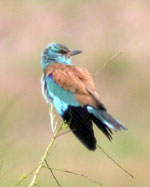 European Roller Coracias garrulus
© John Muddeman
European Roller Coracias garrulus
© John Muddeman
The combination of the diverse geography and
habitats, combined with generally extensive low-intensity management
methods, make the Extremadura region one of the best in Europe for wildlife, especially birds. To put it into perspective,
74.1% of the total surface area qualifies under International IBA criteria (Important Bird Areas), the highest for any
geo-political area in Europe, while considering just the Province of Cáceres, this rises to >90%! While 44 species
of international conservation concern are represented in the area, the real 'stars' in this stage are some of the rarest
and most threatened species in Europe: 49 pp. of Spanish Imperial Eagles (of the approx. 250 pp. that exist), concentrated
in the MonfragŁe and Sierra de San Pedro areas; 910 pp. of Eurasian Black Vulture breed almost exclusively in MonfragŁe
and the Sierra de San Pedro; 97 pp. of Bonelli's Eagle are spread widely across the region (especially the Sierra de San
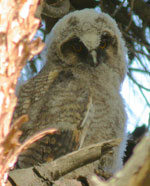 Long-eared Owl Asio otus
© John Muddeman
Pedro and Orellana areas); 195 pp. of Black Stork (c. 60% of the Iberian total are concentrated in the MonfragŁe and Jerez
de los Caballeros areas); and an estimated 5500-6500 Great Bustards (of the c. 24 500 in Spain) are found widely across
the plains.
Long-eared Owl Asio otus
© John Muddeman
Pedro and Orellana areas); 195 pp. of Black Stork (c. 60% of the Iberian total are concentrated in the MonfragŁe and Jerez
de los Caballeros areas); and an estimated 5500-6500 Great Bustards (of the c. 24 500 in Spain) are found widely across
the plains.
Raptors
Not surprisingly, Extremadura is one of the Spanish strongholds for diurnal raptors, including breeding Honey Buzzard,
Black-winged, Black and Red Kites, Egyptian (c. 185 pp.) and Griffon Vultures (c. 1300 pp.), Marsh, Hen and
Montagu's Harriers, Goshawk, Sparrowhawk,
Buzzard, Short-toed, Golden (c. 125 pp.) and Booted Eagles, Lesser (= 3750 pp.) and Common Kestrels, Eurasian Hobby and
Peregrine (c. 50 pp. concentrated in Las Villuercas, Sierra de Gredos and Las Hurdes). Winter visitors include a few Osprey
and Merlin as well as boosting the number of Red Kite, Marsh and Hen Harriers, Sparrowhawk, Common Kestrels and Peregrines,
while a recent news has been the exciting discovery of a small regular wintering population of Egyptian Vultures. Nocturnal
raptors are well represented too: Barn, Scops and Little Owl are all relatively common and widespread, with scarcer Eagle
and Long-eared Owls also found widely. Tawny Owl is widespread in more humid habitats with very small numbers of Short-eared
Owls on passage and winter.
Pseudosteppe Birds and more
Other pseudosteppe birds are also very well represented, though reliable figures on their numbers are difficult to come by.
Little Bustard, Stone-curlew, Pin-tailed and Black-bellied Sandgrouse, Roller, Bee-eater, Calandra and Short-toed Larks and
Black-eared Wheatear are all present, with Collared Pratincole and Gull-billed Tern locally in evidence near river valleys
and reservoirs and Great Spotted Cuckoos along the edges. Sadly, modern farming methods appear to be the main cause of steep
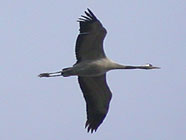 Common Crane Grus grus
© John Muddeman
declines in the numbers of nearly all these species - especially Little Bustard which appears to have declined by up to 75%
in the region over just 10 years - and given current EC farming policies there appears to be no simple way of reversing the
trend away from changes in land use and creeping intensification. Only Spanish Sparrows, feeding in autumn in the rice fields
and breeding in small plantations and dehesa in the spring seem to be benefiting noticeably.
Common Crane Grus grus
© John Muddeman
declines in the numbers of nearly all these species - especially Little Bustard which appears to have declined by up to 75%
in the region over just 10 years - and given current EC farming policies there appears to be no simple way of reversing the
trend away from changes in land use and creeping intensification. Only Spanish Sparrows, feeding in autumn in the rice fields
and breeding in small plantations and dehesa in the spring seem to be benefiting noticeably.
The area has far more on offer than just these highlights, however. White Storks are a common sight, with c. 11 500 pp.,
making this the highest number of any Autonomous Community in Spain, nesting even right in the centre of larger towns and
cities. The dehesa and scrub are home to a plethora of species, including showy Iberian Azure-winged Magpies and Hoopoes,
to rather dowdier Thekla Lark and Short-toed Treecreeper, with Mediterranean warblers in the form of Zitting Cisticola,
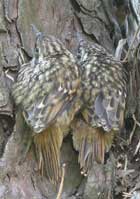 Short-toed Treecreeper Certhia brachydactyla
© John Muddeman
Western Orphean, Melodious, Spectacled, Subalpine and Sardinian Warblers all present. The acorns are not just of importance
to the famous serrano ham producing pigs however, since 45 - 90 000
Common Cranes come annually to winter in
the area (up to 85% of the European population), with Holm Oak acorns being one of their principal food sources of food.
Spilt grain in rice and maize fields is now of major importance to these birds too at certain times, and incredible
concentrations of over 11 000 birds have been seen at one area in S Cáceres.
Short-toed Treecreeper Certhia brachydactyla
© John Muddeman
Western Orphean, Melodious, Spectacled, Subalpine and Sardinian Warblers all present. The acorns are not just of importance
to the famous serrano ham producing pigs however, since 45 - 90 000
Common Cranes come annually to winter in
the area (up to 85% of the European population), with Holm Oak acorns being one of their principal food sources of food.
Spilt grain in rice and maize fields is now of major importance to these birds too at certain times, and incredible
concentrations of over 11 000 birds have been seen at one area in S Cáceres.
Sierras, River Valleys and Wetlands
Rocky outcrops in the sierras and river valleys are also of crucial importance, from breeding raptors and Black Storks,
White-rumped Swift, Blue Rock Thrush, Black Wheatear and Rock Bunting, through to wintering Alpine Accentor and even a very
few Wallcreepers! MonfragŁe National Park is easily the best-known example of this, though many others exist.
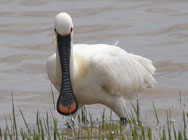 Eurasian Spoonbill
Eurasian Spoonbill
Platalea leucorodia
© John Muddeman
A few wetlands are also magnets to bird life. Little Bittern, Night and Purple Herons, a few pairs of secretive Spoonbills
and Savi's and Great Reed Warblers have found a few corners to their liking alongside two relative newcomers, the delightful
Squacco Heron and the almost absurd-looking Purple Swamp-hen. Remarkably as well, a new reservoir, only created in 1996, rapidly
became extremely attractive to wintering waterfowl, and hit the birding news in 2002 with the discovery of peaks counts of
>100 000 waterbirds, making it the third most important site in Spain after Doñana and the Ebro Delta! Tragically however,
this was created in a small valley which used to house the largest Cattle Egret colony in the western Palearctic (c. 8 000 pp.)
and now supplies water for a macro-irrigation project which is transforming and destroying a large area of
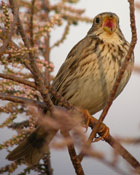 Corn Bunting
Corn Bunting
Miliaria calandra
© John Muddeman
agricultural steppe rich in Lesser Kestrels, both bustards and Black-bellied Sandgrouse amongst others.
High altitude areas of the Sistema Central hold a very different suite of species, including breeding Bluethroat, Rock Thrush
and Ortolan Bunting, with the distinctive Iberian races of Green Woodpecker and Pied Flycatcher present in the upper woodlands
along with Western Bonelli's Warbler, and in pines, abundant Crested Tit and Firecrest.
While this is obviously a brief overview of the area, further information is available on the websites of the main
conservation NGOs operating in the area, ADENEX
and the regional branch of SEO/BirdLife (especially for details of
recent bird sightings and information of interest about the region), plus general information available for Spanish birds
on the SEO/BirdLife website. For a complete
list of species recorded in the region and their statuses, please see the recently updated
list.
Birding in Extremadura
With such an exciting suite of species present in relatively high numbers still surviving in the region, birdwatching in
Extremadura is generally very rewarding, though clearly its inland position means that rarities are not commonly encountered.
That said, despite good habitat often being found surprisingly close to built-up areas, the huge scale of many of the habitats
can also frustrate and potentially disappoint birdwatchers, and local birding knowledge is often crucial for finding many species.
A couple of good books cover the region, including "A Birdwatching Guide to Extremadura",
with the second edition due for publication in 2010. Alternatively, our local knowledge will lead you to
the best sites and key species of their habitats on our programmed birdwatching and wildlife
tours or during tailor-made birding trips, for the best birding
in Extremadura.
|